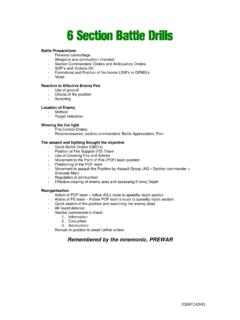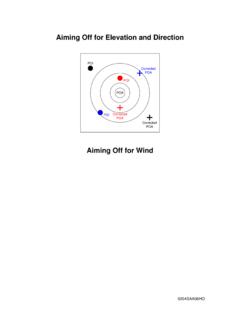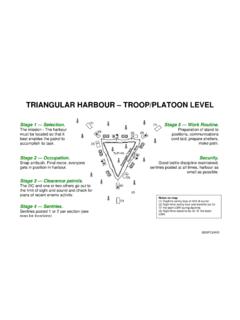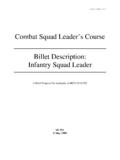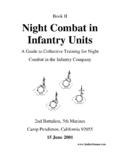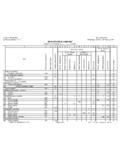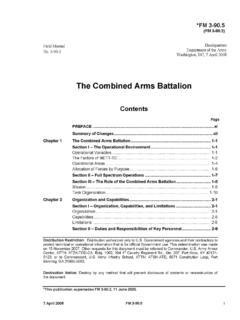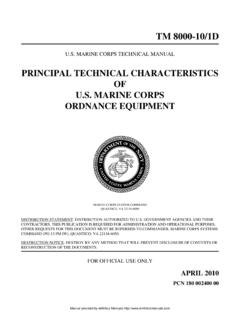Transcription of DEFINITIONS, WORDS OF COMMAND AND …
1 Page 1 of 6 0302DR24-25LC DEFINITIONS, WORDS OF COMMAND AND DIRECTING FLANKS Definitions Covering The act of placing oneself directly behind another body. Dressing Aligning ones self with and covering others within a body of cadets. Rank A line of cadets side by side. Single File Cadets one behind another on a frontage of one at normal marching distance. Blank File A file in which there is no centre or rear cadet, or no centre cadet, due to the inequality of numbers within a body of cadets. This file is second from the left in three ranks and third from the left in two ranks. Flank Either side of a body as opposed to its front or rear. Directing Flank The flank by which a body of cadets takes its dressing. Other less used definitions Alignment A straight line on which a body of troops is formed or is to form. Depth The space occupied by a body of troops from front to rear. Distance The space between men or bodies from front to rear.
2 File Either two or three cadets of different ranks who are covering each other, or a body of troops in two ranks facing a flank. Markers Men employed to mark points on which a movement is to be directed or by which a formation or alignment is to regulated. Page 2 of 6 0302DR24-25LC General This is by no means exhaustive. There are many drill movements. You must practice. If you are in a squad , listen to the WORDS of COMMAND and learn from them. It is important to get your drill commands correct. The cadets will expect it. If you get a COMMAND wrong, the cadets will get confused and you will look foolish. If you get a COMMAND wrong, or the cadets move a different way than you intended, the first thing you should say is, "AS YOU WERE" This COMMAND means disregard my last order. Once the cadets have assumed the previous position, give a correct order. If an individual cadet gets the movement wrong, the order should be, "CORRECT YOURSELF (Never humiliate a cadet) WORDS of COMMAND All WORDS of COMMAND should be given as orders; clear, loud & with pauses.
3 There are three parts to a word of COMMAND Introductory, Cautionary and Executive. Introductory Before a squad is turned in any direction whether at the halt or on the march, the direction is indicated by an introductory word of COMMAND . This word of COMMAND will vary depending on the direction that the squad is facing when the COMMAND is given. The constant factors in determining the direction that the squad is facing and the direction that it is to face will be the front rank and the right hand cadet of the squad . "MOVE TO THE RIGHT IN THREES" Cautionary The cautionary word of COMMAND should be consistently drawn out over about the equivalent of four paces in quick time. "R--I--G--H--T". There should be a pause between it and the executive word of COMMAND of: a) At the Halt the regulation pause. b) In Quick Time about four paces.
4 C) In Slow Time about three paces. Page 3 of 6 0302DR24-25LC Executive The executive word of COMMAND should be given as a high pitched, short, sharp COMMAND to inspire instant reaction from the squad . "TURN!" Possible Commands There are many possible commands when taking drill and they depend on the following. 1. Who are you giving the order to and what do you call them? If you are drilling a body of cadets who could not be covered by any of the WORDS below, it is safe to use " squad ". squad is the usual COMMAND , but it is not always correct. A group of cadets who are on an assessment could be called "CADRE" A star wing should be referred to as "WING" if all or most are present. A Company (or a group of cadets representing the Company) should be called "COMPANY" If a single unit is on parade, it is courteous to use their unit title "PLATOON, SQUADRON", etc. If more than one Coy or Plt is on parade, the title used is "PARADE".
5 Escorts to Colours are always referred to by the whole title "ESCORT TO THE COLOUR". The title "DETAIL" is only ever used if people have been specifically named "Cadets Smith, Jones and Williams". "DETAIL, DETAIL, SHUN". "FALL OUT" This means that the three cadets detailed should fall out. You should never use names in a COMMAND . 2. Which is the advance, retire, left and right? Generally, the advance is the place where you gave the first COMMAND from. Usually the advance, retire, Left & Right never change once a COMMAND has been given from that position. However, other factors may mean that the advance is changed. If there is a saluting dais, flag pole, or other obvious centre of attention on the square, then that direction may become the advance. If there are officers or adults on parade, or due to come on parade, they will usually be to the front of the formed up body. This will become the advance. Page 4 of 6 0302DR24-25LC Expect anyone taking over a parade from you to give drill commands with their position as the new advance.
6 You should not make the situation worse by changing it back. 3. Which direction are the cadets facing? The content of the introductory word of COMMAND is dependant on which way the cadets are facing. You must remember which is the advance and which is the retire. 4. Which way do you want them to go? 5. How many in the group and how many ranks/files? In the previous section, the COMMAND "IN THREES" is used. You should only use "IN THREES" when the COMMAND is a static change of direction. Any body of cadets larger than 9, should always be in three ranks. If the Page 5 of 6 0302DR24-25LC squad is a small one (9 cadets or under) there should be only two ranks. In this instance you should use "IN FILE . If for some reason the squad is in single file, it is quite correct to use, "IN SINGLE FILE". If a body of cadets has Officers, Adults or Senior Cadets, either out in front, or forming a supernumerary (extra) rank behind; the phrase "IN COLUMN OF ROUTE" may be used.
7 This is generally only used by the Parade Commander when he wants to turn a parade to the right or left. What will happen is that any personnel out in front will march off towards the front of the parade. Any personnel behind will march off to the rear of the parade. A parade marching in column of route will revert back to "In Threes" when it is halted. Remember to give time for personnel at the front and rear to return to their original positions 6. Dressing when a squad is marching The commands "BY THE RIGHT/LEFT" are used as part of the introductory WORDS of COMMAND when you are moving off a body of cadets. For example, "BY THE RIGHT, QUICK MARCH" or "BY THE LEFT, QUICK MARCH" Generally you should dress from the Right Marker. Depending on where he/she is, will dictate whether you dress by the right or left. A dressing is also given when a squad is wheeled round. Dress by the inside cadet not the cadet on the outside rank. If a squad is losing a dressing whilst marching, it is correct to give the COMMAND , "BY THE RIGHT/LEFT" to remind the squad which way they should dress from.
8 The COMMAND "BY THE FRONT" is only ever used when a single file is being marched. The COMMAND "BY THE CENTRE" is used for military bands and when a squad carries out a march past in review order. 7. On which foot do you give cautionary and executive WORDS of COMMAND ? When marching, it is sometimes confusing as to when a cautionary or executive COMMAND is given. The simple answer is (in quick time only) as the left heel strikes the ground except: Change Step given as "CHANGE STEP" as Left then Right heels strike the ground. Page 6 of 6 0302DR24-25LC Left Turn given as "TURN" as the right heel strikes the ground. About Turn given as "TURN" the left passing the right. For drill commands given in Quick Time, the cautionary is given over the length of time it would take to march four paces. It is a good idea to start the cautionary word of COMMAND on the same foot that the executive is given on. By doing this, the squad is not kept waiting for the executive COMMAND .
9 Time and Pace Every instructor should know the rates of marching, lengths of pace and timings of foot and arms drill that are laid out below: Rates of Marching. Quick Time (normal) 116 paces to the minute. Quick Time (Recruits) up to 140 paces to the minute. Quick Time (Light Infantry and Green Jacket Regiments) 140 paces to the minute. Slow Time (normal) 65 paces to the minute. Slow Time (Light Infantry and Green Jacket Regiments) 70 paces to the minute. Double Time 180 paces to the minute. Lengths of Pace Quick and Slow Time 750 mm (30 inches). Stepping Out 830 mm (33 inches). Stepping Short 530 mm (21 inches). Double Time 1000 mm (40 inches).
10 Side Pace 300 mm (12 inches). Timing of Foot and Arms Drill A pause is judged between movements of foot and arms drill which would allow 40 movements to be completed in a minute; this is called the regulation pause.



